Welcome to Somerston, Napa Valley’s Newest Winery!
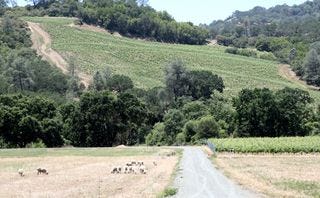
If you ever wanted to learn about the terroir of Napa Valley, Somerston Winery’s a good place to do it.
Napa Valley’s newest winery (it opened to the public yesterday) features more than 87 distinct growing blocks, five completely different soil types, multiple sources of water each with different mineral properties, and the ranch sprawls across a tall ridge, which joins two different valley systems.
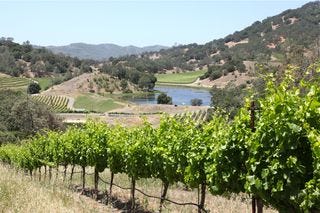
Somerston, the creation of real estate developer Allan Chapman, has been seven years in the making. In 2004, Allan started acquiring land on Sage Canyon Road, ten miles beyond Pritchard Hill and Lake Hennessey.
The winery’s mail address may be St. Helena, but the isolated, mountainous location has as little to do with the tony town. If anything, visiting Somerston to party for an afternoon, is like heading out on a safari. Be sure to pack your water bottles, sunscreen and photo equipment.
Somerston owner Allan Chapman
Allan, born in Newcastle, UK, studied at Cambridge University and came to America via Vancouver. The bulk of his career has been spent in real estate and telecommunications. Allan says that he had no expectation that one day he would own a 1,626-acre winery in Napa Valley.
There are 17 different grape varieties planted between 800- and 2200-feet elevation at Somerston. More than 200 acres are planted.
After speaking with Allan, I understand how he thinks and why he’s been successful at business; it’s in his genes. Allan’s family operated and sailed giant clipper chips in the 1850s era in England.
“In those days, in England, the annual crop of Indian tea would run out before the next year’s crop was picked and delivered. As soon as the next new crop of tea was picked, whoever got it from India, or Ceylon, to England first, was able to charge five times more than the market price; consumers bid up the price of the newly arrived, new-crop tea,” explains Allan.
Allan’s family realized that if they added great billowing sails to transport boats, and built and sailed giant clipper ships, they could make the voyage from India to England much faster than others, landing the new-crop tea first on the shores of England and earning themselves a premium price for the tea.
“My family was able to build a new sailing clipper each year with the profits,” says Allan.
I’m not sure the same rules apply in bringing new-crop Nouveau Cabernet to market in Napa Valley, Allan, so maybe don’t think about applying this strategy to your winery business….
Even so, to honor his family’s shipping heritage, many of the planted blocks and vineyards at Somerston are named after Allan’s family sailing ships.
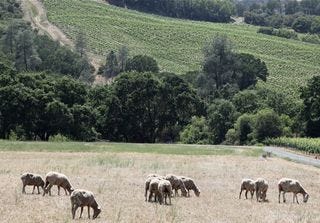
Today, 1500-head of Dorper sheep, originally from South Africa, graze in the vineyards, eating weeds and keeping grasses short. “We call this organic fire control,” quips Allan, who is intent on ultimately getting full organic certification for the property.
“At present, everything we do here is sustainable farming; in fact, we are building a solar power system, which will completely remove us from the outside electrical grid,” says Jim Provance II, a staff wine specialist at Somerston.
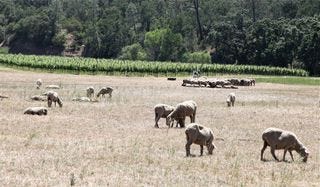
Even the sheep at Somerston get immaculate care and attention; they’re day-cared by a Peruvian shepherd who moves the herd to different blocks to keep them fed and the grasslands trimmed.
The winery occupies a site formerly known as Priest Ranch, named after Joshua James Priest, who landed in California in 1847 to stake a claim in the gold rush.
That’s the winery barn at a distance in the middle of the shot; above it tower the quarries where miners thought they would extract gold; instead, they found a source of bubbly, mineral-rich, soda, which was bottled and sold for its reputed healing properties.
Priest thought that bits of bright blue glass, which speckled on the property, indicated the presence of gold. But instead of gold, Joshua discovered a hidden natural soda springs on the property. The natural waters were bottled on the property and sold for their reputed healing powers.
While beverages bottled on the ranch today may lack health-curing powers, they contain alcohol, which will help anyone forget they have issues requiring medical attention.
In fact, three different wine brands are produced here: Somerston, Priest Ranch and Highflyer. Premium wines carry the Somerston label.
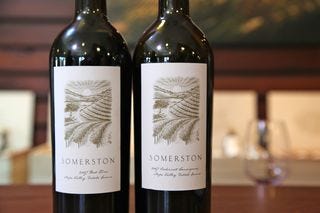
Among Somerston reds, the two I tried and liked are:
2007 Somerston Proprietary Red, a blend of 97 percent Merlot and 3 percent Cabernet Franc. $90. Only 150 cases made.
2007 Somerston Cab, which is 100 percent estate Cabernet. $120. 250 cases produced.
To celebrate the opening of the winery, Allan and his winemaker-partner, Craig Becker, hosted an all-day party Saturday.
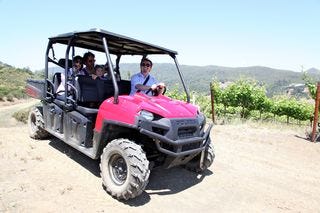
Wine specialist Jim Provance II takes guests on zippy 20-minute rides through the vineyards
They offered rides on All Terrain Vehicles (ATVs), which scootered over the ridges and through the vineyards. They generously fed guests and looked after their beverage needs, too.
Now that the winery is open to the public, here’s what you need to know:
With a booked appointment, visitors get a ride through the vineyards, a tasting flight of three Somerston wines, complementary local cheeses and freshly made pate.
The cost is $50 per person. The ATVs make their 20-minute run through the vineyards three times daily -- at 11 am, 1 pm and 3 pm. To book space, call 707-967-8414. Or check details at www.somerstonwineco.com.
The winery is at 3450 Sage Canyon Rd. Set your GPS device to read “St. Helena” for ‘city.’
Can’t make it to the farm? Somerston also operates a tasting room in Yountville at 6490 Washington St.

